I’m always on the lookout for solid saltwater cleanup crews for my aquariums, and the Astraea star snail is a fantastic pick. Also known as the Astraea conehead snail, these little guys are small but mighty when it comes to munching on algae. Plus, they’ve got those unique star-shaped shells that make them pretty eye-catching too.
These reef-safe snails are essential in my tank’s cleanup crew. Even though they’re small, they have a big appetite for algae, keeping things neat and tidy. I also love how their green shells can develop pink or purple hues over time, adding a nice pop of color to my reef setup.
Native to the Caribbean and the western Atlantic Ocean, Astraea conehead snails are a must-have in my community tank. While they’re typically active at night in the wild, they switch to daytime activity in tanks, constantly working on the rocks and sand beds. They do a great job of helping keep my aquatic home healthy, vibrant, and algae-free!
Introduction to Astraea Snail
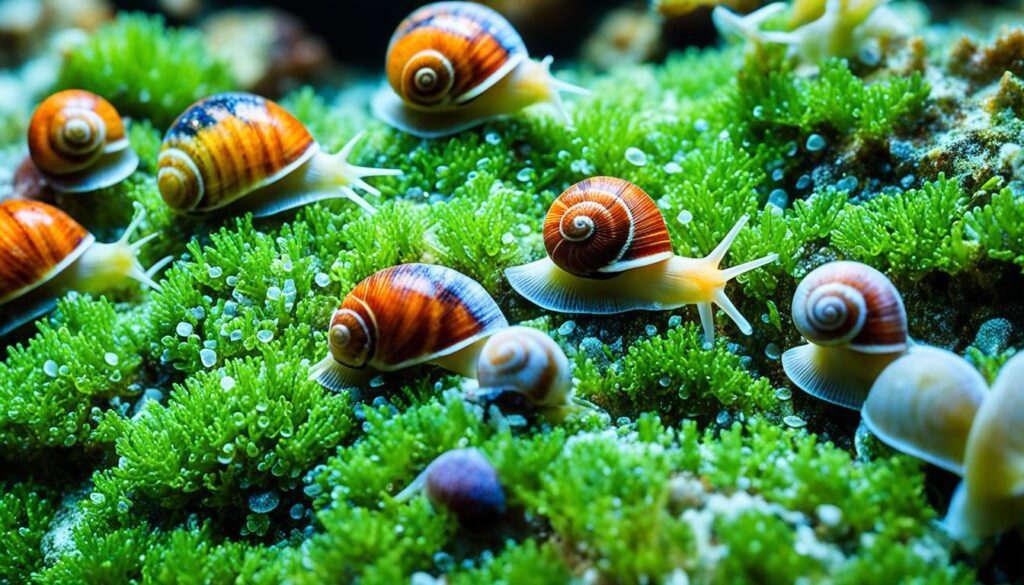
When diving into the world of saltwater aquariums, it’s key to know about captive Astraea snails. They are vital for cleaning and maintaining the health of marine settings.
The Astraea Snail in Saltwater Aquariums
In saltwater tanks, Astraea snails stand out for their algae-eating skills. These little but powerful snails are crucial for a healthy coral reef. Many aquarium owners, including myself, have seen their tanks become cleaner with these snails. At a cost of just $1 to $3, they are an economical option for algae control.
Native Habitats of the Astraea Snail
Astraea snails come from the colorful waters of the Caribbean and the Atlantic Ocean. They do best in settings that mimic these rich underwater worlds. The right salinity, pH, and temperature are essential for their health. This lets them help clean the tank by eating algae on surfaces and live rocks.
Parameter |
Description |
|---|---|
Origin |
Caribbean, Atlantic Ocean |
Average Size |
1-2 inches (2.5 – 5 cm) |
Lifespan |
2-3 years |
Water Temperature |
72 – 78°F (22-25.5°C) |
pH |
8.1 – 8.4 |
Salinity |
1.023 – 1.025 |
Calcium Levels |
350 – 450 ppm |
Sensitivity |
High nitrate levels, copper |
Feedback from marine cleanup crew keepers shows Astraea snails’ usefulness and how easy they are to care for. They are a strong choice for many home saltwater aquariums.
The Distinctive Appearance of Astraea Snails

Aquatic pets are truly fascinating, and discussing species like the Astraea snail is always exciting. We’ll explore the colorful snail shells and astraea snail shell coloration.
A key feature that grabs attention is the unique shell patterning of Astraea snails. These patterns are vital for snail shell identification. The shells usually have a green tint. Yet, in areas with lots of coralline algae, their shells can turn pink or purple. This change boosts both their looks and their ability to blend in.
Many Astraea snails have shells with pronounced projections, creating a star-like appearance. This makes them captivating in any aquarium. They become a prime focus for photographers and enthusiasts who love colorful snail shells.
Let’s take a moment for a closer look at an Astraea snail’s vivid beauty.
Knowing where these snails thrive and how to care for them is key. The astraea snail shell coloration tells a lot about their health. It changes with light and algae in their environment.
The mix of colorful snail shells, unique shell patterning, and their color changes is endlessly intriguing. Astraea snails offer much to appreciate and study, whether in the wild or an aquarium.
Astraea Snail Size and Growth Patterns
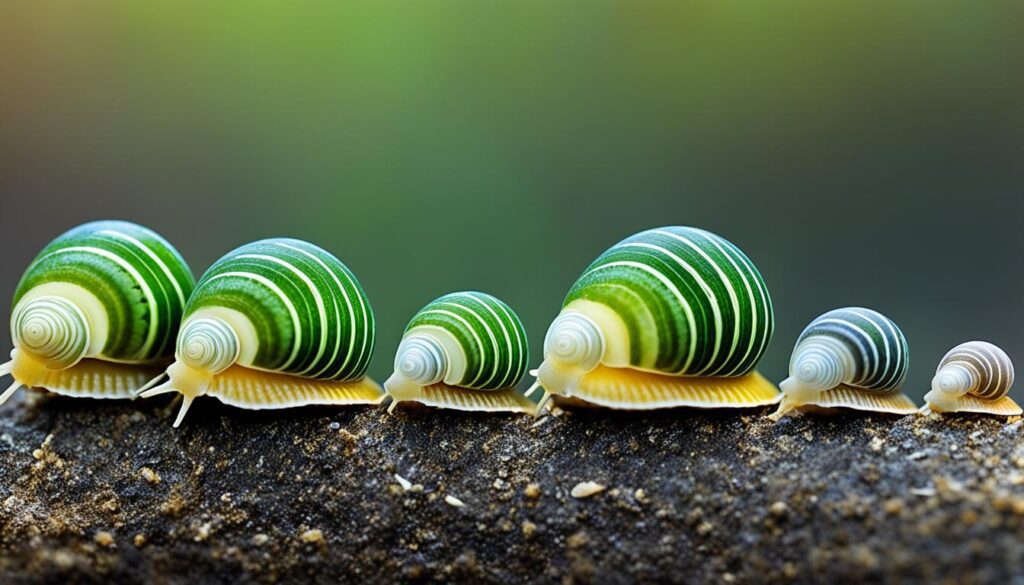
Exploring the astraea snail size shows how they fit into different water worlds. The mature astraea snails have special features for living in many marine places.
Typical Size Range of Adult Astraea Snails
An astraea snail’s size gives clues about its well-being and living place. Normally, astraea snail size can reach up to 2 inches wide. This size lets them move in reef tank crannies easily. But their size isn’t just about their genes; things around them matter a lot, too.
Factors Influencing Growth Rates
Their growth gets shaped by where they live, showing us what they need to survive. Calcium in water is vital as it makes their shells strong. This helps them stay safe from predators and tough surroundings.
Also, fighting for food and space strongly impacts their size. In crowded spots, snails tend to be smaller because food is scarce. But in open spaces, they grow bigger, thanks to plenty of resources.
This leads to an interesting pattern in how snail sizes change with their living density:
Population Density |
Mean Individual Size |
Growth Rate Variation |
|---|---|---|
High |
Smaller |
Decreased Growth |
Moderate |
Medium |
Moderate Growth |
Low |
Larger |
Increased Growth |
Bird Rock, Santa Catalina Island, showed an interesting trend. The more snails in a spot, the smaller each one tends to be. This shows more than fighting for food. It shows how mature astraea snails deal with their world.
Understanding the Lifespan of Astraea Snails
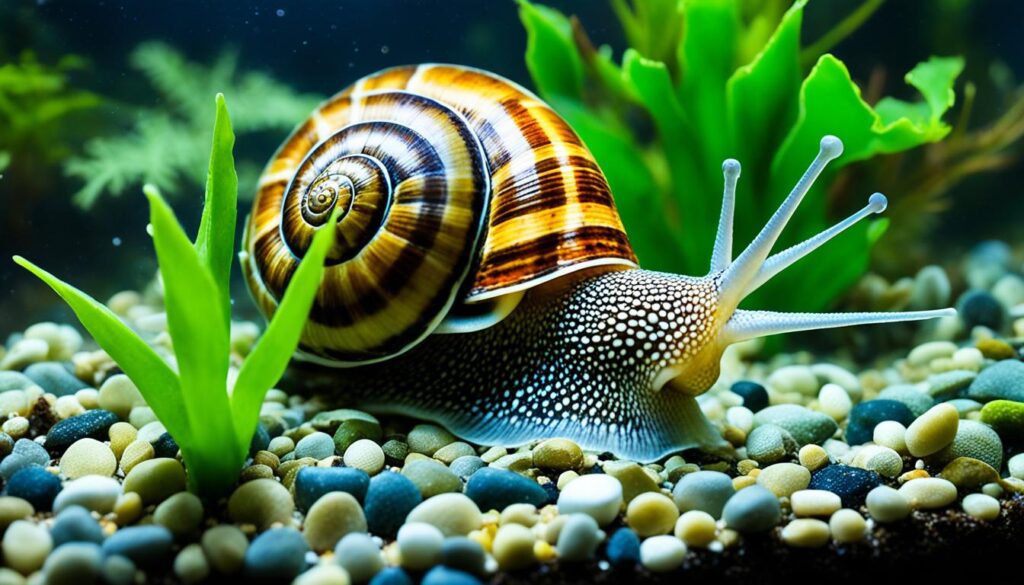
When we talk about astraea snail longevity, we find they can live from 1 to 5 years. Their long life is due to factors like their environment and how we take care of them. They are durable aquarium snails loved by many fish keepers. I’m here to help you understand why they live so long and are tough marine gastropods.
To help these snails live longer, good living conditions are crucial. Keeping an eye on water quality is important. Things like stable pH and temperature have a big impact on their health. They mainly eat algae, so giving them various types, such as veggie rounds and spirulina, is good. This diet keeps them healthy and helps clean your tank.
- Proper Acclimation: Slowly getting them used to their new home reduces stress and helps them live longer.
- Avoid Overfeeding: Too much food can make the water quality worse. This is bad for astraea snail longevity.
- Maintain Low Nitrate Levels: They don’t do well with high nitrates or copper meds. So, keeping the water right is essential.
In short, you can help your marine gastropods live up to five years or more with proper care. Making sure your durable aquarium snails have what they need means they can be a part of your tank for a long time. They not only look cool but also keep your tank clean. This adds beauty and health to your underwater world.
Astraea Snail Breeding Facts and Indicators
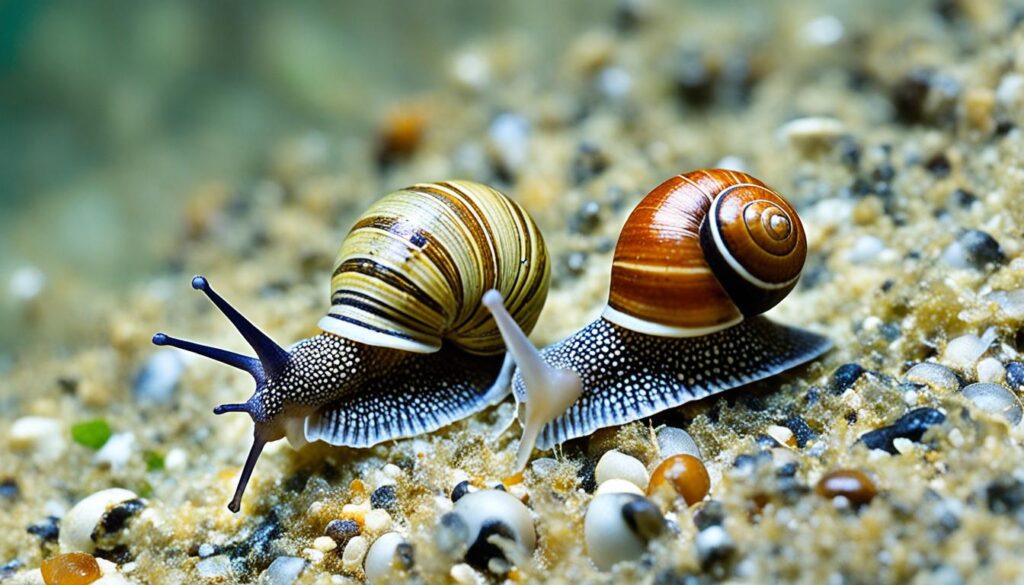
Successful astraea snail breeding is about knowing their reproduction and mirroring their natural world. Snail breeding in the sea is complex, needing close watch and care. For Astraea snail enthusiasts, preparing and being patient lets you see the amazing event of marine snail spawning.
Recognizing Spontaneous Breeding Behaviors
Most Astraea snail breeding happens by chance in stable aquariums. To know when they’re ready to spawn, look for more activity and gatherings. Marine snail spawning often happens in May and from July to October. This matches with what we’ve seen in similar species.
Creating Optimal Conditions for Reproduction
To promote astraea snail breeding, ensure your water mimics their natural home. Important factors are keeping the water temperature between 23 and 34°C and the salinity at 31 to 36 ppt. Here’s what you can do:
- Watch and keep water temperature and salinity stable to avoid stressing the snails.
- Keep aquarium nitrate levels under 10 ppm to prevent too much algae, which harms water quality.
- If you can, mimic the natural tidal flow in your aquarium setup to imitate the ocean.
- Use lessons from successful breeding efforts. Small changes in environment could trigger spawning.
Stick to these steps and keep an eye on your tank. Doing so, you’ll likely have a tank that supports Astraea snail natural breeding behaviors.
Parameter |
Optimal Range |
Impact on Breeding |
|---|---|---|
Temperature (°C) |
23 – 34 |
Stimulates spawning |
Salinity (ppt) |
31 – 36 |
Mimics natural seascape |
Nitrate (ppm) |
Prevents harmful algae overgrowth |
Creating a Suitable Habitat: Tank Requirements for Astraea Snails
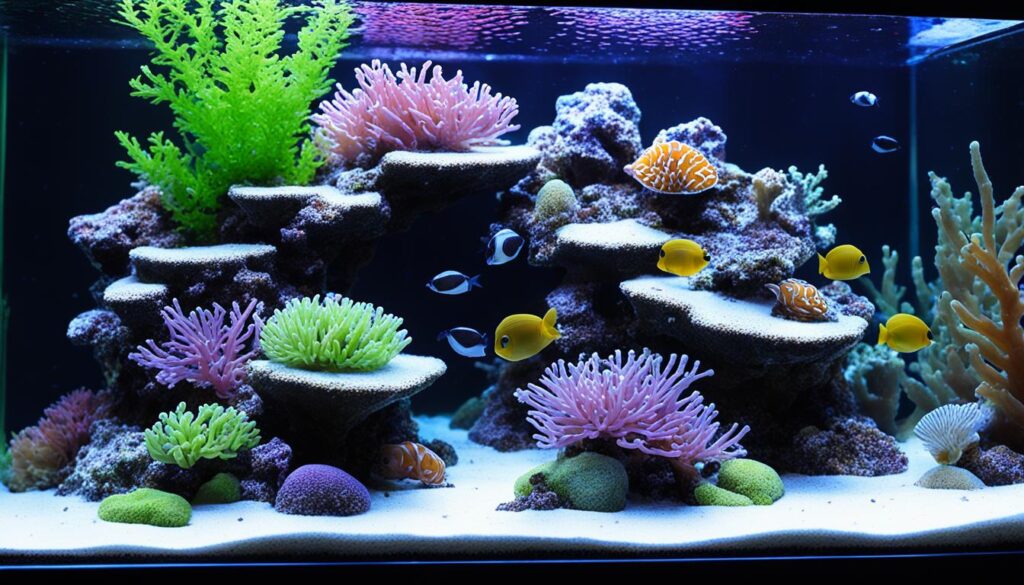
To create a good home for astraea snails, you need a marine tank like their natural home. These snails do well in tanks with lots of rocks and a sandbed. These help them eat and act like they would in the wild.
A clean sandbed is key for these snails. It helps them eat and keeps the tank healthy. Also, it’s vital to keep the tank conditions stable for their well-being. The tank’s temperature should be between 72°F and 80°F. The specific gravity needs to be 1.020 to 1.024, with a pH of 8 to 8.4.
- Tank Size: A 10-gallon tank is the minimum size recommended for housing Astraea snails effectively.
- Lifespan: Typically, these snails enjoy a lifespan of around 2-3 years, contributing to biofiltration and algae control in the tank.
- Size: Astraea snails grow to about 1 inch in size, making them a manageable and beneficial addition to any marine tank setup.
- Availability: Readily available as aquacultured species, they are known to be hardier and more adaptable than their wild-caught counterparts.
- Compatibility: Peaceful in nature, Astraea snails coexist well with most fish and coral species.
- Reproduction: Although they have the capabilities, Astraea snails rarely reproduce in captivity, influenced by their environmental conditions.
Setting up an aquarium for Astraea snails means more than just meeting their basic needs. It should also reflect the complexity and stability of natural reefs. This approach ensures not just their survival, but their flourishing in your marine tank.
Dietary Needs and Feeding Strategies for Astraea Snails
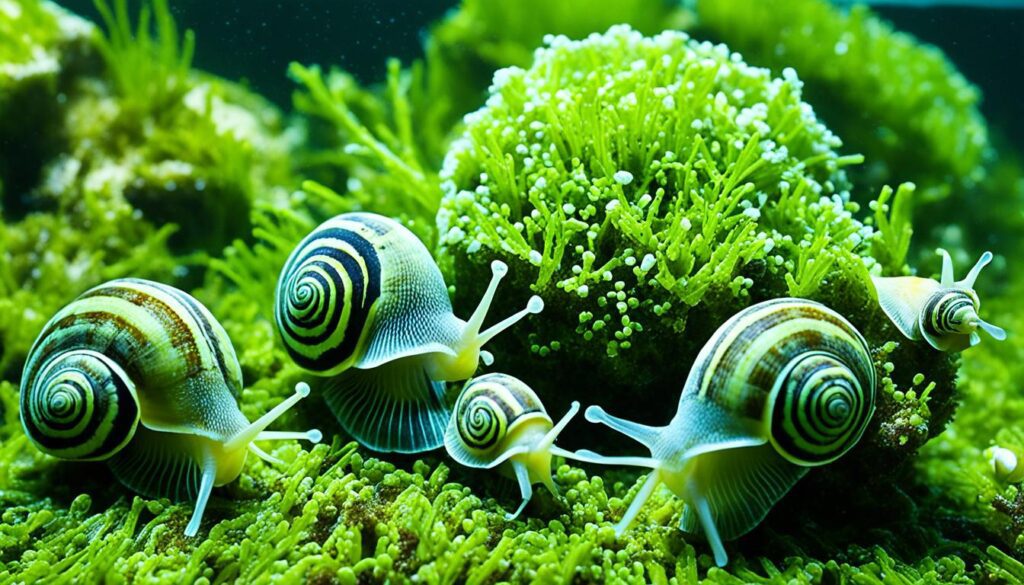
It’s key to grasp the astraea snail diet and marine snail feeding ways. That way, you keep them hale and the aquarium’s balance right. They are herbivores, mainly eating algae and other green things off tank surfaces.
Natural Algae Grazers and Food Preferences
Astraea snails love munching on different algae kinds, like green algae and diatoms. They help your tank stay clean and airy by eating away the algae. This means clearer glass and decor without the green gunk.
Still, when algae get scarce, these snails need more food. Keep an eye on algae so there’s enough, but not too much. You don’t want it taking over!
Supplementing the Astraea Snail Diet in Captive Tanks
If there’s not enough natural algae, you can add special foods. Try veggie rounds or blanched veggies like zucchini, spinach, and kale. Algae wafers and spirulina tablets work well too.
With algae-eating snail care, steady feeding is vital. It stops overeating, which can mess up the water and make snails sick. Mixing natural and extra foods helps your snails and the tank thrive.
Watch their eating to tweak what you feed them. This ensures they get all needed nutrients while keeping the tank tip-top. A well-cared-for snail makes for a spotless, thriving tank.
Selecting Compatible Tank Mates for the Astraea Snail
When setting up my reef aquarium, I focus on picking the right friends for astraea snails. I aim to build a place where everyone lives well together. Choosing peaceful creatures is key. This way, the Astraea Snails can eat algae without trouble. Many recommend Sand Sifting Starfish as friends, making up 17% of similar setups. They’re calm and help keep the tank clean by sifting the sand.
I look for good deals for tank mates like the Mini Maxi Anemone, now $225, down from $300. Also, the Clam – Crocea, now 17% off at $375. It’s important they get along with Astraea Snails. The Gold Ring Cowrie, costing $12.50 to $30.00, is a great choice too. Same with the Redline Cleaner Shrimp, though it’s $200. They all play a part in keeping the tank clean.
Thinking about adding fish? Do your homework. Consider the Molly Fish. They can live for 5 years and grow 5-6 inches. Prices range from $15 to $100. Remember, Astraea Snails do best in a 5-gallon tank. So, pick tank mates that won’t get too big. It’s important to think about how big every creature will get. Our goal is to create a beautiful, diverse marine world where everyone supports each other.








